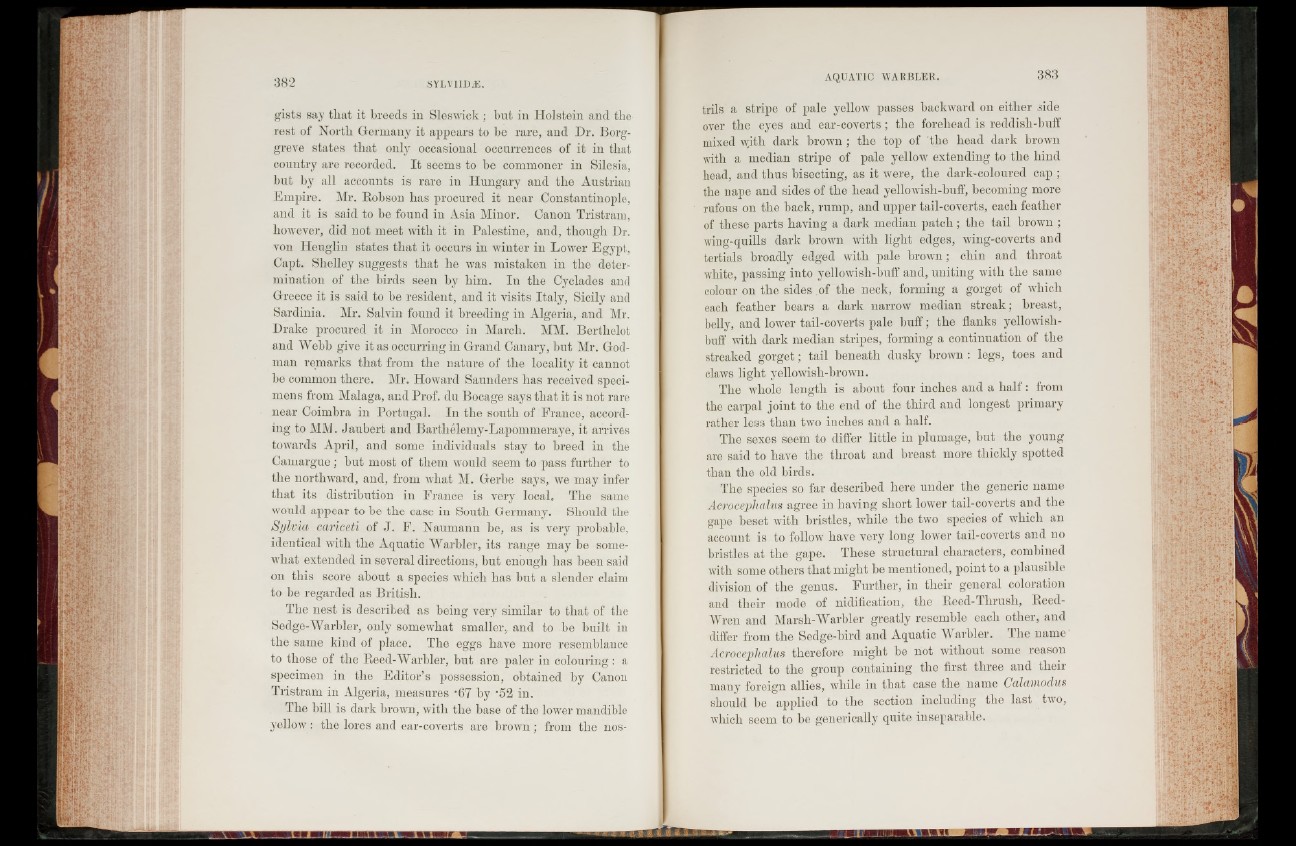
gists say that it breeds in Sleswick; but in Holstein and the
rest of North Germany it appears to be rare, and Dr. Borg-
greve states that only occasional occurrences of it in that
country are recorded. I t seems to be commoner in Silesia,
but by all accounts is rare in Hungary and the Austrian
Empire. Mr. Robson has procured it near Constantinople,
and it is said to be found in Asia Minor. Canon Tristram,
however, did not meet with it in Palestine, and, though Dr.
von Heuglin states that it occurs in winter in Lower Egypt,
Capt. Shelley suggests that he was mistaken in the determination
of the birds seen by him. In the Cyclades and
Greece it is said to be resident, and it visits Italy, Sicily and
Sardinia. Mr. Salvin found it breeding in Algeria, and Mr.
Drake procured it in Morocco in March. MM. Berthelot
and Webb give it as occurring in Grand Canary, but Mr. God-
man remarks that from the nature of the locality it cannot
be common there. Mr. Howard Saunders has received specimens
from Malaga, and Prof. du Bocage says that it is not rare
near Coimbra in Portugal. In the south of France, according
to MM. Jaubert and Barthelemy-Lapommeraye, it arrives
towards April, and some individuals stay to breed in the
Camargue; but most of them would seem to pass further to
the northward, and, from what M. Gerbe says, we may infer
that its distribution in France is very local. The same
would appear to be the case in South Germany. Should the
Sylvia cariceti of J . F. Naumann be, as is very probable,
identical with the Aquatic Warbler, its range may be somewhat
extended in several directions, hut enough has been said
on this score about a species which has but a slender claim
to be regarded as British.
The nest is described as being very similar to that of the
Sedge-Warbler, only somewhat smaller, and to be built in
the same kind of place. The eggs have more resemblance
to those of the Reed-Warbler, hut are paler in colouring: a
specimen in the Editor’s possession, obtained by Canon
Tristram in Algeria, measures -67 by ’52 in.
The bill is dark brown, with the base of the lower mandible
yellow: the lores and ear-coverts are brown ; from the nostrils
a stripe of pale yellow passes backward on either side
over the eyes and ear-coverts; the forehead is reddish-buff
mixed with dark brown; the top of the head dark brown
with a median stripe of pale yellow extending to the hind
head, and thus bisecting, as it were, the dark-coloured cap ;
the nape and sides of the head yellowish-buff, becoming more
rufous on the back, rump, and upper tail-coverts, each feather
of these parts having a dark median patch; the tail brown ;
wing-quills dark brown with light edges, wing-coverts and
tertials broadly edged with pale brown; chin and throat
white, passing into yellowish-buff and, uniting with the same
colour on the sides of the neck, forming a gorget of which
each feather bears a dark narrow median streak; breast,
b e l l y , and lower tail-coverts pale buff; the flanks yellowish -
buff with dark median stripes, forming a continuation of the
streaked gorget; tail beneath dusky brown: legs, toes and
claw's light yellowish-brown.
The whole length is about four inches and a h a lf: from
the carpal joint to the end of the third and longest primary
rather less than two inches and a half.
The sexes seem to differ little in plumage, but the young
are said to have the throat and breast more thickly spotted
than the old birds.
The species so far described here under the generic name
Acrocephalus agree in having short lower tail-coverts and the
gape beset with bristles, while the two species of which an
account is to follow’ have very long lower tail-coverts and no
bristles at the gape. These structural characters, combined
with some others that might he mentioned, point to a plausible
division of the genus. Further, in their general coloration
and their mode of nidification, the Reed-Thrush, Reed-
Wren and Marsh-Warbler greatly resemble each other, and
differ from the Sedge-bird and Aquatic W arbler. The name
Acroceplicdus therefore might be not without some reason
restricted to the group containing the first three and their
many foreign allies, while in that case the name Coluwioclus
should be applied to the section including the last two,
which seem to he generically quite inseparable.